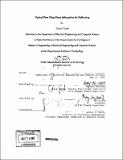Optical flow using phase information for deblurring
Author(s)
Texin, Cheryl (Cheryl A.)
DownloadFull printable version (23.77Mb)
Alternative title
Correcting motion blur using optical flow
Other Contributors
Massachusetts Institute of Technology. Dept. of Electrical Engineering and Computer Science.
Advisor
Michael Matranga and Jae S. Lim.
Terms of use
Metadata
Show full item recordAbstract
This thesis presents a method for reconstructing motion-degraded images by using velocity information generated with a phase-based optical flow calculation. The optical flow method applies a set of frequency-tuned Gabor filters to an image sequence in order to determine the component velocities for each pixel by tracking temporally separated phase contours. The resulting set of component velocities is normalized and averaged to generate a single 2D velocity at each pixel in the image. The 2D optical flow velocity is used to estimate the motion-blur PSF for the image reconstruction process, which applies a regularization filter to each pixel. The 2D velocities generally had small angular and magnitude errors. Image sequences where the motion varied from frame to frame had poorer results than image sequences where the motion was constant across all frames. The quality of the deblurred image is directly affected by the quality of the velocity vectors generated with the optical flow calculations. When accurate 2D velocities are provided, the deblurring process generates sharp results for most types of motion. The magnitude error proved to be a larger problem than the angular error, due to the averaging process involved in creating the 2D velocity vectors from the component velocities. Both the optical flow and deblurring components had difficulty handling rotational motion, where the linearized model of the motion vector is inappropriate. Retaining the component velocities may solve the problem of linearization.
Description
Thesis (M. Eng.)--Massachusetts Institute of Technology, Dept. of Electrical Engineering and Computer Science, 2007. Includes bibliographical references (p. 121-123).
Date issued
2007Department
Massachusetts Institute of Technology. Department of Electrical Engineering and Computer SciencePublisher
Massachusetts Institute of Technology
Keywords
Electrical Engineering and Computer Science.